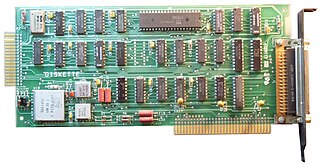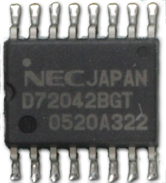This article needs additional citations for verification .(October 2016) |

The Intel 8257 is a direct memory access (DMA) controller, a part of the MCS 85 microprocessor family. The chip is supplied in 40-pin DIP package.
This article needs additional citations for verification .(October 2016) |

The Intel 8257 is a direct memory access (DMA) controller, a part of the MCS 85 microprocessor family. The chip is supplied in 40-pin DIP package.

The Intel 8080 ("eighty-eighty") is the second 8-bit microprocessor designed and manufactured by Intel. It first appeared in April 1974 and is an extended and enhanced variant of the earlier 8008 design, although without binary compatibility. The initial specified clock rate or frequency limit was 2 MHz, with common instructions using 4, 5, 7, 10, or 11 cycles. As a result, the processor is able to execute several hundred thousand instructions per second. Two faster variants, the 8080A-1 and 8080A-2, became available later with clock frequency limits of 3.125 MHz and 2.63 MHz respectively. The 8080 needs two support chips to function in most applications: the i8224 clock generator/driver and the i8228 bus controller. It is implemented in N-type metal–oxide–semiconductor logic (NMOS) using non-saturated enhancement mode transistors as loads thus demanding a +12 V and a −5 V voltage in addition to the main transistor–transistor logic (TTL) compatible +5 V.

The 8086 is a 16-bit microprocessor chip designed by Intel between early 1976 and June 8, 1978, when it was released. The Intel 8088, released July 1, 1979, is a slightly modified chip with an external 8-bit data bus, and is notable as the processor used in the original IBM PC design.
Direct memory access (DMA) is a feature of computer systems that allows certain hardware subsystems to access main system memory independently of the central processing unit (CPU).

The MCS-48 microcontroller series, Intel's first microcontroller, was originally released in 1976. Its first members were 8048, 8035 and 8748. The 8048 is arguably the most prominent member of the family. Initially, this family was produced using NMOS technology. In the early 1980s, it became available in CMOS technology. It was manufactured into the 1990s to support older designs that still used it.

The Intel 8085 ("eighty-eighty-five") is an 8-bit microprocessor produced by Intel and introduced in March 1976. It is software-binary compatible with the more-famous Intel 8080 with only two minor instructions added to support its added interrupt and serial input/output features. However, it requires less support circuitry, allowing simpler and less expensive microcomputer systems to be built. The "5" in the part number highlighted the fact that the 8085 uses a single +5-volt (V) power supply by using depletion-mode transistors, rather than requiring the +5 V, −5 V and +12 V supplies needed by the 8080. This capability matched that of the competing Z80, a popular 8080-derived CPU introduced the year before. These processors could be used in computers running the CP/M operating system.
A blitter is a circuit, sometimes as a coprocessor or a logic block on a microprocessor, dedicated to the rapid movement and modification of data within a computer's memory. A blitter can copy large quantities of data from one memory area to another relatively quickly, and in parallel with the CPU, while freeing up the CPU's more complex capabilities for other operations. A typical use for a blitter is the movement of a bitmap, such as windows and icons in a graphical user interface or images and backgrounds in a 2D video game. The name comes from the bit blit operation of the 1973 Xerox Alto, which stands for bit-block transfer. A blit operation is more than a memory copy, because it can involve data that's not byte aligned, handling transparent pixels, and various ways of combining the source and destination data.

Masatoshi Shima is a Japanese electronics engineer. He was one of the architects of the world's first microprocessor, the Intel 4004. In 1968, Shima worked for Busicom in Japan, and did the logic design for a specialized CPU to be translated into three-chip custom chips. In 1969, he worked with Intel's Ted Hoff and Stanley Mazor to reduce the three-chip Busicom proposal into a one-chip architecture. In 1970, that architecture was transformed into a silicon chip, the Intel 4004, by Federico Faggin, with Shima's assistance in logic design.
4-bit computing is the use of computer architectures in which integers and other data units are 4 bits wide. 4-bit central processing unit (CPU) and arithmetic logic unit (ALU) architectures are those that are based on registers or data buses of that size. A group of four bits is also called a nibble and has 24 = 16 possible values.

The NEC V20 is a microprocessor that was designed and produced by NEC. It is both pin compatible and object code compatible with the Intel 8088, with an instruction set architecture (ISA) similar to that of the Intel 80188 with some extensions. The V20 was introduced in March 1984.

The Low Pin Count (LPC) bus is a computer bus used on IBM-compatible personal computers to connect low-bandwidth devices to the CPU, such as the BIOS ROM, "legacy" I/O devices, and Trusted Platform Module (TPM). "Legacy" I/O devices usually include serial and parallel ports, PS/2 keyboard, PS/2 mouse, and floppy disk controller.

A floppy-disk controller (FDC) has evolved from a discrete set of components on one or more circuit boards to a special-purpose integrated circuit or a component thereof. An FDC directs and controls reading from and writing to a computer's floppy disk drive (FDD). The FDC is responsible for reading data presented from the host computer and converting it to the drive's on-disk format using one of a number of encoding schemes, like FM encoding or MFM encoding, and reading those formats and returning it to its original binary values.
The NEC μPD7720 is the name of fixed point digital signal processors from NEC. Announced in 1980, it became, along with the Texas Instruments TMS32010, one of the most popular DSPs of its day.
V850 is a 32-bit RISC CPU architecture produced by Renesas Electronics for embedded microcontrollers. It was designed by NEC as a replacement for their earlier NEC V60 family, and was introduced shortly before NEC sold their designs to Renesas in the early 1990s. It has continued to be developed by Renesas as of 2018.

The NEC V25 (μPD70320) is the microcontroller version of the NEC V20 processor, manufactured by NEC Corporation. Features include:

IEBus is a communication bus specification "between equipments within a vehicle or a chassis" of Renesas Electronics. It defines OSI model layer 1 and layer 2 specification. IEBus is mainly used for car audio and car navigations, which established de facto standard in Japan, though SAE J1850 is major in United States.
IEBus is also used in some vending machines, which major customer is Fuji Electric. Each button on the vending machine has an IEBus ID, i.e. has a controller.
Detailed specification is disclosed to licensees only, but protocol analyzers are provided from some test equipment vendors. Its modulation method is PWM with 6.00 MHz base clock originally, but most of automotive customers use 6.291 MHz, and physical layer is a pair of differential signalling harness. Its physical layer adopts half-duplex, asynchronous, and multi-master communication with carrier-sense multiple access with collision detection (CSMA/CD) for medium access control. It allows for up to fifty units on one bus over a maximum length of 150 meters. Two differential signalling lines are used with Bus+ / Bus− naming, sometimes labeled as Data(+) / Data(−).

The PC-8000 series is a line of personal computers developed for the Japanese market by NEC. The PC-8001 model was also sold in the United States and Canada as the PC-8001A.

Intel 8237 is a direct memory access (DMA) controller, a part of the MCS 85 microprocessor family. It enables data transfer between memory and the I/O with reduced load on the system's main processor by providing the memory with control signals and memory address information during the DMA transfer.

The High-Performance Graphics Display Controller 7220 is a video display processor capable of drawing lines, circles, arcs, and character graphics to a bit-mapped display. It was developed by Nippon Electric Company (NEC) in order to support the Kanji character set efficiently, which explains why the APC computer line had superior graphics compared to competing models. The chip was first used in the NEC N5200 and in later computers, such as the NEC PC-9801, APC II and APC III, the NECcomputer, the optional graphics module for the DEC Rainbow, the NCR Decision Mate V, the Tulip System-1, and the Epson QX-10.

The Radio-86RK is a build-it-yourself home computer designed in the Soviet Union. It was featured in the popular Radio magazine for radio hams and electronics hobbyists in 1986. The letters RK in the title stands for the words Radio ham's Computer. Design of the computer was published in a series of articles describing its logical structure, electrical circuitry, drawings of printed circuit boards and firmware. The computer could be built entirely out of standard off-the-shelf parts. Later it was also available in a kit form as well as fully assembled form.
The NEC μCOM series is a series of microprocessors and microcontrollers manufactured by NEC in the 1970s and 1980s. The initial entries in the series were custom-designed 4 and 16-bit designs, but later models in the series were mostly based on the Intel 8080 and Zilog Z80 8-bit designs, and later, the Intel 8086 16-bit design. Most of the line was replaced in 1984 by the NEC V20, an Intel 8088 clone.